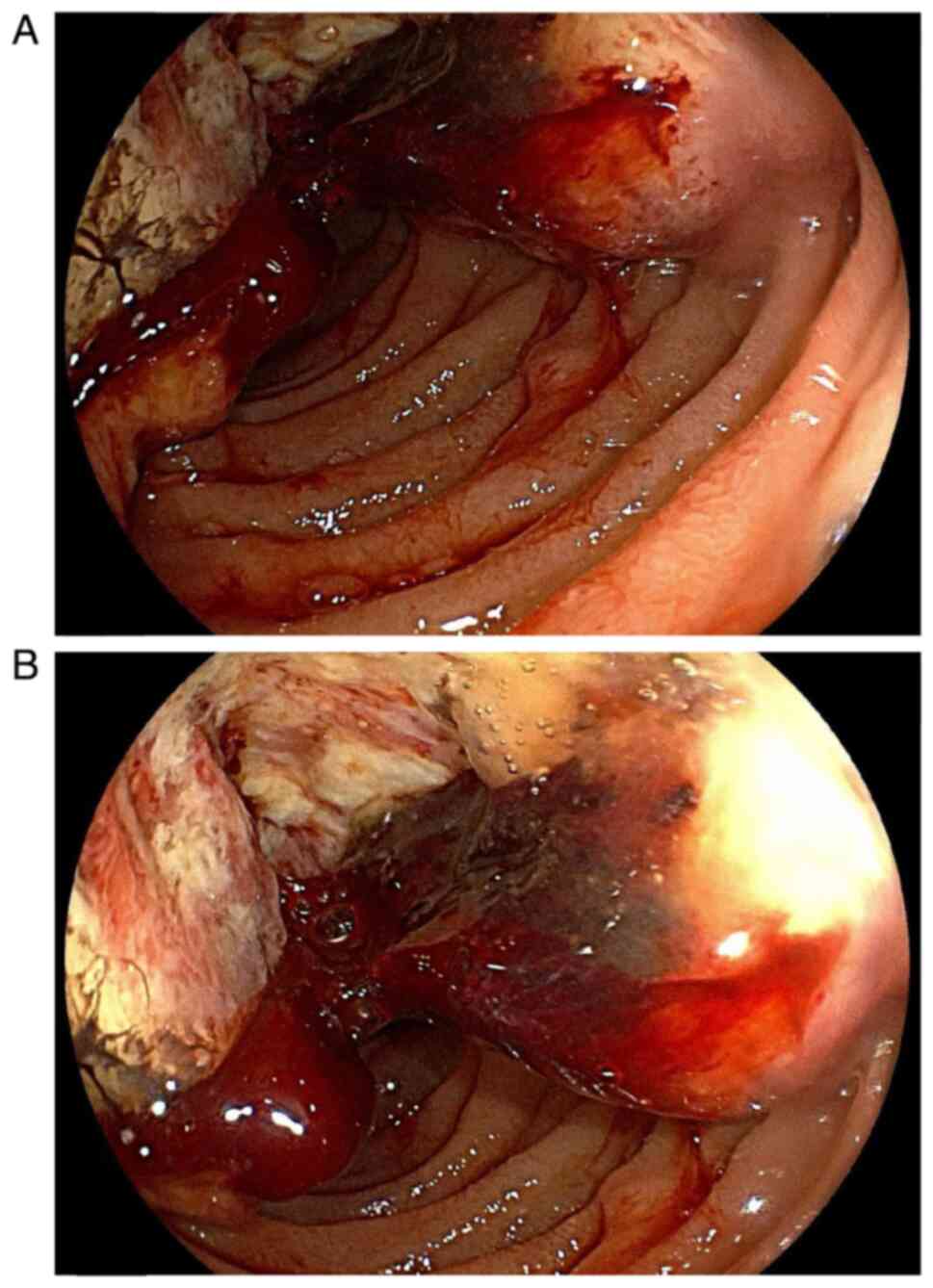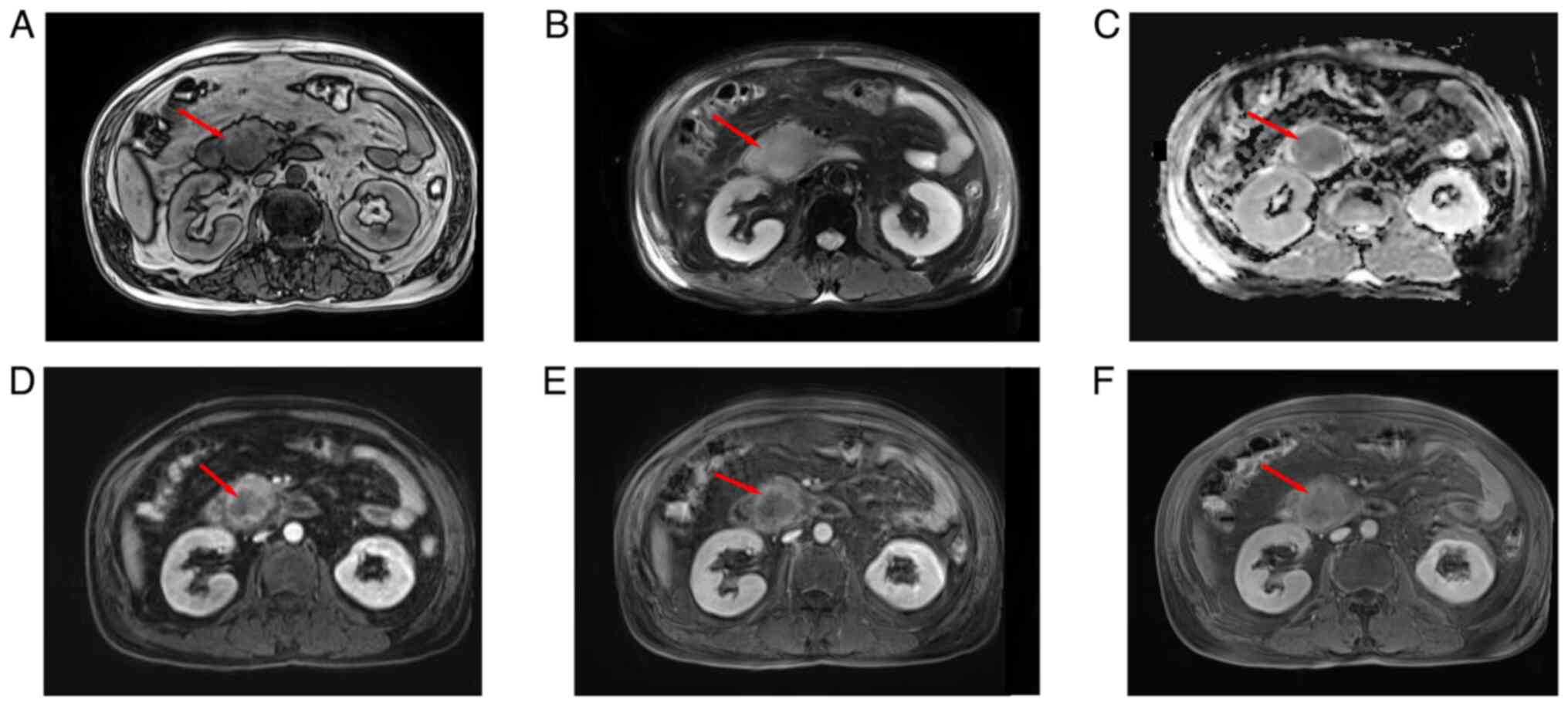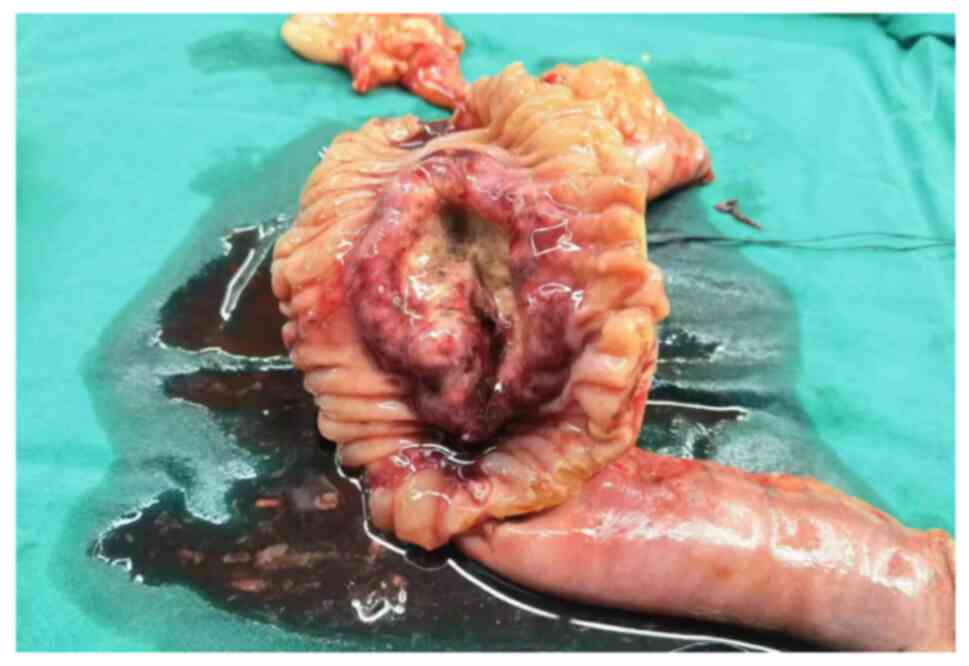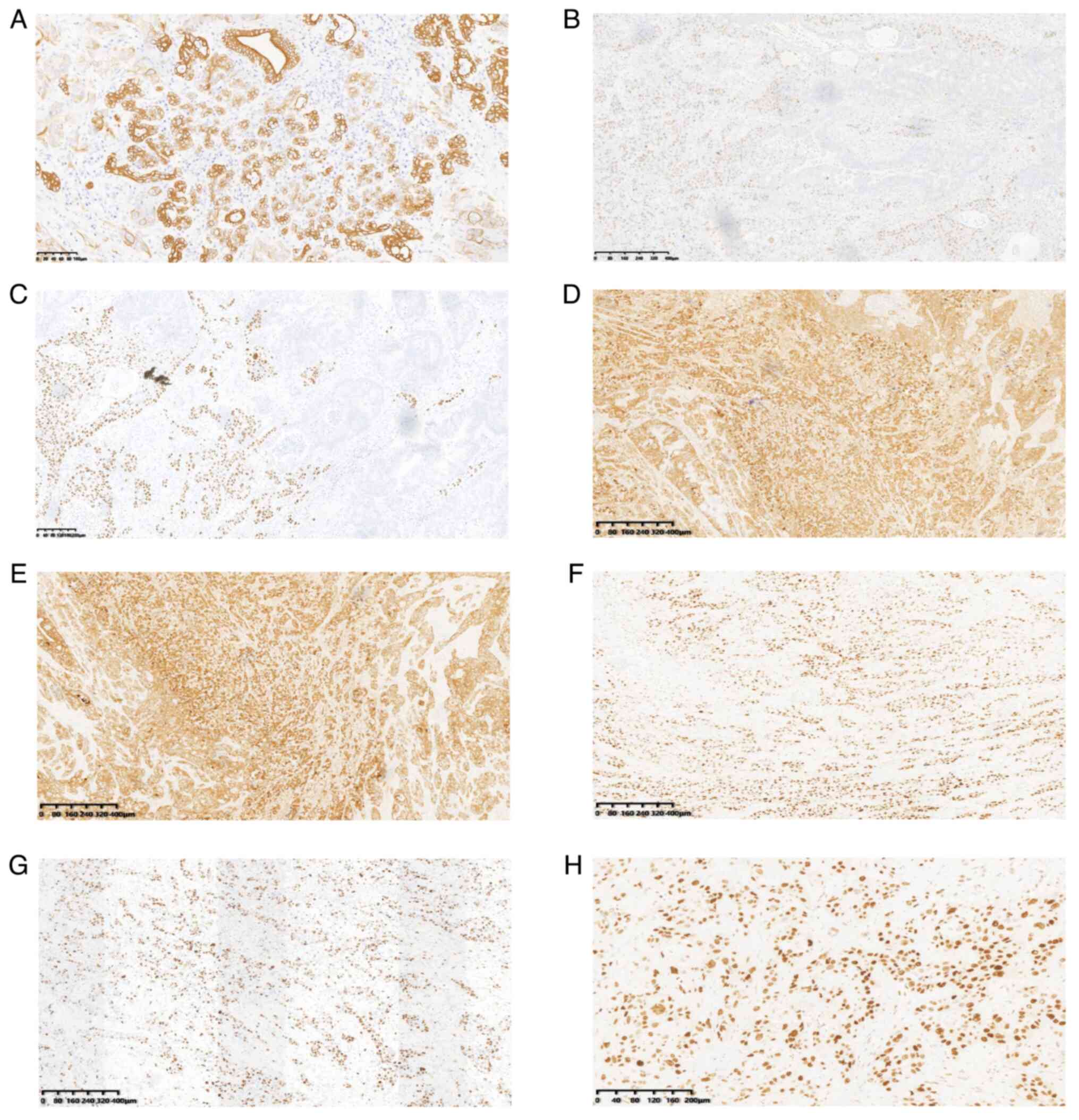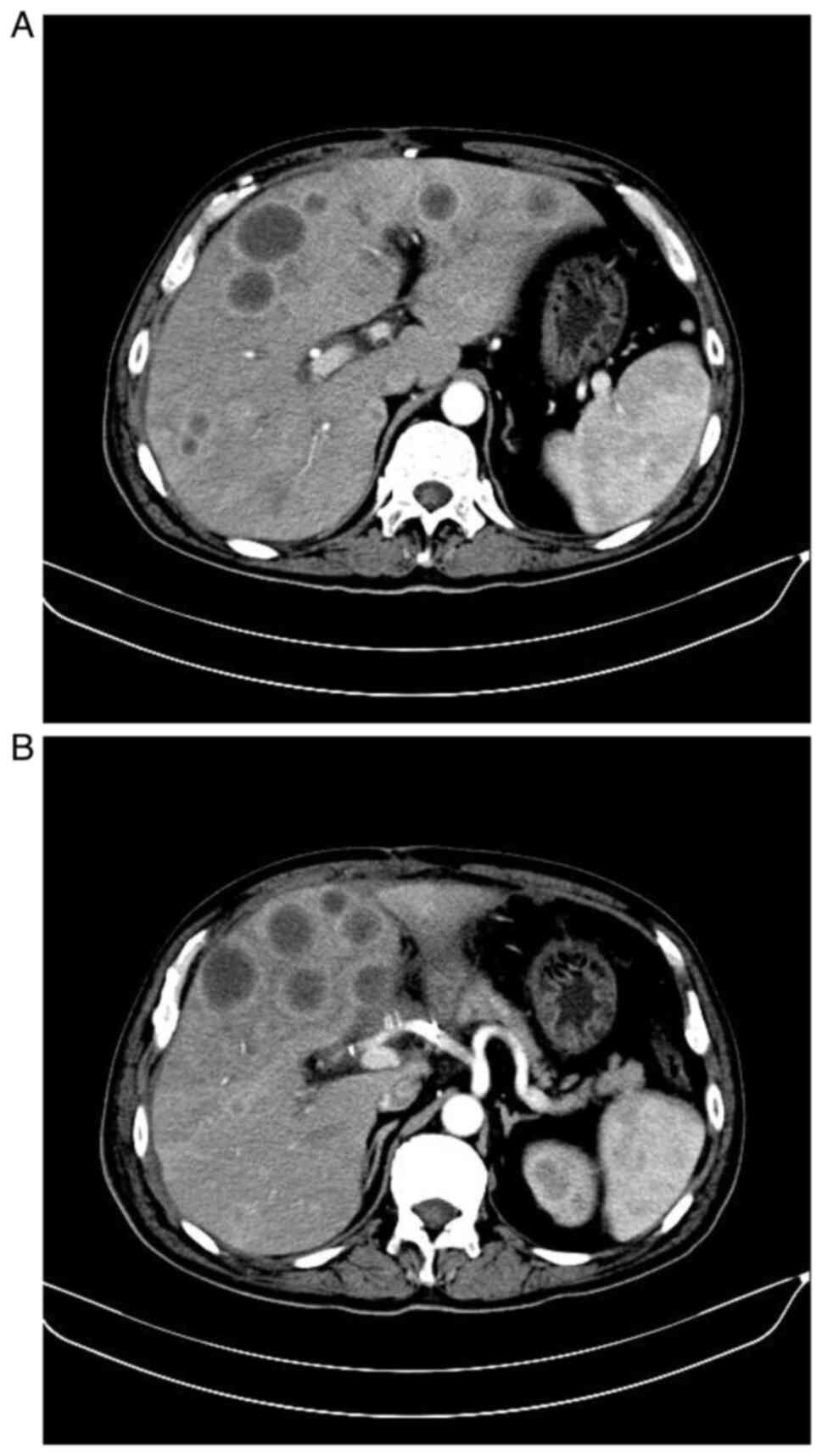Primary adenosquamous carcinoma of the duodenum: A case report with literature review
- Authors:
- Published online on: October 21, 2024 https://doi.org/10.3892/ol.2024.14762
- Article Number: 16
-
Copyright: © Zhang et al. This is an open access article distributed under the terms of Creative Commons Attribution License.
Abstract
Introduction
Adenosquamous carcinoma (ASC) is defined as a malignant tumor comprised of adenocarcinoma and components of squamous cell carcinoma, with a low incidence rate according to the World Health Organization (WHO) Classification of Tumors of the Digestive System 2019 (1). Surveillance, Epidemiology and End Results databases have reported that the number of cases of gastrointestinal ASC in the United States from 1973 to 2020 accounted for 20% of all ASC cases (2). ASC can occur in various organs, such as the lung, pancreas, gallbladder, breast, stomach, cervix, colon and rectum. Nevertheless, primary duodenal ASC is exceedingly rare (3–9). So far, only ~18 cases of primary duodenal ASC have been reported, and basic and large-scale clinical studies remain unavailable. Duodenal ASC faces several clinical challenges. The preoperative diagnosis is difficult due to non-specific clinical and imaging presentations, as well as the low diagnostic accuracy of biopsies. Additionally, since only a few cases of duodenal ASC have been reported, no standard medical approach has been established and the prognosis of duodenal ASC remains unclear. Previous studies (10–12) have reported that ASC generally has a poorer prognosis and is clinically more aggressive than its adenocarcinoma counterpart (13).
The current report aims to present a rare case of primary duodenal ASC and to review the literature to enhance our clinical understanding and guide treatment strategies for the disease.
Case report
A 55-year-old man presented to Wenzhou Central Hospital (Wenzhou, China) with a 1-month history of jaundice and fever in January 2023. The patient also had a history of weight loss and anorexia, along with pruritus and clay-colored stools for 3 months. No familial/hereditary cancer syndrome was reported in the family history. Laboratory investigations revealed the following: Serum total bilirubin, 304.1 µmol/l (normal, 0–26 µmol/l); aspartate aminotransferase, 127 U/l (normal, 15–40 U/l); alanine aminotransferase, 76 U/l (normal, 9–50 U/l); alkaline phosphatase, 263 U/l (normal, 45–145 U/l); CA125, 94.4 kU/l (normal, 0–24 kU/l) and CA19-9 (18,444 kU/l; normal, 0–25 kU/l). AFP, 1.4 µg/l (normal, 0–7 µg/l) and CEA, 4.4 µg/l (normal, 0–5 µg/l) were normal. Gastroscopy showed a hyperplastic and increased mass in the descending portion of the duodenum, which was irregular in shape, covered with Inflammatory necrotic tissue and blood, presented with mucosal erosion and congestion, and encroached on the duodenal papilla (Fig. 1A and B). An enhanced magnetic resonance imaging (MRI) scan revealed a soft-tissue mass in the descending duodenum, with dilation of the intra- and extra-hepatic bile ducts, but without pancreatic duct dilation. A space-occupying mass was observed in the uncinate process of the pancreas, as well as a right intrahepatic bile duct stone (Fig. 2A-F). There was no evidence of lymphadenopathy or distant metastatic disease.
The patient underwent an R0 Whipple procedure. Regional lymphatic dissection with a midline incision near the upper abdomen was used for radical resection of the duodenal lesion. There was no ascites, liver metastasis or peritoneal seeding. Fig. 3 shows the surgically resected specimen. The gross tumor specimen displayed an ulcerated mass visible at the descendant duodenum that measured ~7.0×6.8×5.5 cm, was greyish in color and had poorly defined borders, encroaching on the head of the pancreas (Fig. 3). Tumor tissue was immersed in 10% formalin at room temperature for 24 h for fixation, followed by dehydration in alcohol. The tissue was then placed in xylene and embedded in paraffin wax. Cut the wax block into 4 µm slices. The slices are then subjected to a series of dewaxing and hydration steps. The nucleus was subjected to hematoxylin staining for 3 min, while the cytoplasm underwent eosin staining for 1 min at room temperature. Finally, the prepared slides were observed under a light microscope (magnification, ×50 and ×100). The pathological diagnosis was of a primary duodenal ASC invading the pancreas. The tumor was comprised of two components, namely, poorly differentiated adenocarcinoma and squamous cell carcinoma. These two components were mixed without clear borders. The poorly differentiated adenocarcinoma was comprised of imprinted cells with cytoplasmic mucin, and the squamous carcinoma consisted of keratinized polygonal cells arranged in nests (Fig. 4A and B). There were no regional lymph node metastases or peripheral nerve and vascular infiltrative lesions. No cancer cells were observed in the duodenal resection margins, peripancreatic tissue resection margins, common bile duct resection margins, pancreatic resection margins or gastric resection margins. Tumor tissues were immersed in 10% formalin at room temperature for 24 h for fixation, then made into paraffin sections for immunohistochemical analysis. Tumor paraffin tissue sections were deparaffinized, rehydrated, sealed with 3% hydrogen peroxide, and repaired with EDTA for antigen. The slices were then incubated with primary antibody (1:200) at 4°C overnight. They were subsequently blocked with 5% bovine serum albumin (A1933, Sigma, Missouri, United States) for 30 min at 37°C. Then incubated with 100 µl HRP-conjugated rabbit anti-goat IgG polymer (ZSGB-BIO, Beijing, China, cat. no. PV-9003) at 37°C for 60 min and observed with diaminobenzidine (DAB). The nuclei were then stained with hematoxylin at 25°C for 3 min. Images of representative tissues are captured using a light microscope (magnification, ×100 and ×200). The supplier and catalog number of the primary antibody used are as follows: CK7 (ZSGB-BIO, Beijing, China, cat. no. ZA0573), p40 (Maixin, Henan, China, cat. no. RAB0666), p63 (Maixin, Henan, China, cat. no. MAB0694), CK5/6 (ZSGB-BIO, Beijing, China, cat. no. ZA0683), CK19 (Maixin, Henan, China, cat. no. Kit0030), p53 (ZSGB-BIO, Beijing, China, cat. no. ZM0408), Ki-67 (ZSGB-BIO, Beijing, China, cat. no. ZM0166). Immunohistochemical analysis revealed that the tumor cells diffusely expressed cytokeratin 7 (CK7; Fig. 5A). The squamous carcinoma cells were positive for tumor protein p40 (p40) (Fig. 5B) and p63 (Fig. 5C), CK5/6 (Fig. 5D), whereas other immunohistochemical indexes were positive for CK19 (Fig. 5E) and p53 (Fig. 5F), and ~60% positive for Ki-67 (Fig. 5G and H).
The patient was postoperatively stable and discharged from the hospital after 2 weeks. At the 2-month postoperative follow-up, enhanced computed tomography (CT) scan revealed multiple metastatic lesions in the liver (Fig. 6A and B). The pathological outcomes of a liver puncture showed ASC cells, which were diagnosed as duodenal ASC liver metastasis. The patient succumbed to the disease at 6 months after surgery.
Literature review
Using ‘duodenum’ and ‘adenosquamous carcinoma’ as the search terms, secondary adenosquamous carcinoma of duodenum and adenosquamous carcinoma of ampulare were excluded, and primary adenosquamous carcinoma of duodenum was excluded. Language limitations were overcome with language translators. The search period was limited to January 1, 1980 to January 1, 2024. A systematic search of the PubMed (pubmed.ncbi.nlm.nih.gov), Embase (www.embase.com), China National Knowledge Infrastructure (https://www.cnki.net), WanFang (http://www.wanfangdata.com.cn) and J-STAGE databases (http://www.jstage.jst.go.jp/browse) identified 18 cases of primary duodenal ASC. Information was compiled on patient demographics, clinical features, surgical modalities, radiotherapy regimens, lymph node and distant metastases, and follow-up. Table I summarizes the demographics, clinical features, treatments and outcomes of the reported duodenal ASC cases.
Discussion
Malignant tumors of the small intestine are extremely rare, accounting for ~3% of all gastrointestinal malignancies. The most prevalent histological subtypes include adenocarcinomas, neuroendocrine tumors and gastrointestinal mesenchymal stromal tumors, while ASC originating in the duodenum is rare (14). To date, limited cases have been documented in the English literature. According to the WHO definition, ASC should be comprised of different numbers of adenocarcinoma and squamous cell carcinoma components. The boundary between the two components may be unclear or these two components may be completely separated. In the present case, no clear boundary was noted between the adenocarcinoma and squamous cell carcinoma components. The origin of these tumors remains unclear. Several theories have been fronted to explain the histopathological mechanisms of squamous and glandular epithelium within the same tumor, including i) the presence of pluripotent epithelial stem cells that can trigger malignant transformation of both cell types, ii) squamous metaplasia in intestinal mucosa/adenocarcinomas and iii) collision of the two malignant tumors (15,16).
The present literature review finally identified 18 reported cases (17–31) of primary duodenal ASC (Table I). The median age of reported cases was 73 years (range, 25–84 years), with a slight male predominance (55.6%). The present case of a 55-year-old man fits within the broader demographic profile. Non-specific digestive system symptoms, as well as symptoms caused by tumor bleeding, were the most common clinical manifestations of duodenal ASC. Available reports indicate that duodenal ASC may present with clinical manifestations such as fever, abdominal pain, vomiting, weight loss, loss of appetite, hematemesis, hematochezia, jaundice, bilirubinuria and white clay-like stools. Due to tumor invasion of the duodenal papilla, the clinical manifestations of obstructive jaundice and clay-colored stools in the present duodenal ASC case are consistent with previous report (20).
From the literature review, key findings include the challenging preoperative diagnosis and the aggressive nature of duodenal ASC, as evidenced by its rapid metastasis and poor prognosis. However, imaging is not specific and literature summarizing the imaging features of duodenal ASC remains unavailable. The most prevalent imaging presentation in the available case reports was an ill-defined space-occupying lesion in the duodenal lumen, with inhomogeneous enhancement of the interior of the mass on CT or MRI-enhanced scans. Regarding the pathological diagnosis, the WHO Classification of Tumors of the Digestive System, 2019, does not restrict the diagnostic ratio of the two components of ASC, and there is no consensus in the current literature. This is due to the manual selection of the microscopic field of view and differences in evaluating the ratio of the two components. Although preoperative endoscopic biopsy improves the preoperative diagnostic rate, several reports have misdiagnosed duodenal ASC as adenocarcinoma or squamous carcinoma preoperatively due to the inability to obtain both cellular components by puncture biopsy (17). Thus, the diagnosis of duodenal ASC currently relies on postoperative pathological biopsy or autopsy. The commonly used immunohistochemical antibodies in diagnosing ASC include p63, CK5/6, CK7 and CK8 (32–34). The hematoxylin and eosin, and immunohistochemistry results in the present case revealed the presence of both adenocarcinoma and squamous carcinoma components in the tumor, which is in line with the histological features of ASC. Meanwhile, immunohistochemical indicators can be used to aid in diagnosing and predicting prognosis. For instance, high levels of p63 expression in tumor tissues have been linked to a poor prognosis in several digestive cancer types, such as colorectal, gastric and gallbladder cancers (35–37). Lee et al (38) and Kim et al (39) discovered that a poor prognosis in gastric ASC may be caused by p53 upregulation and a high Ki-67 index. The immunohistochemical outcomes of the present patient showed positive results for p63 and p53, and ~60% positivity for Ki-67, suggesting a poor prognosis.
In terms of treatment, the ideal approach for duodenal ASC remains unknown, and surgical resection is the standard clinical treatment. A total of 16 (88.9%) of the 18 patients in the present literature review underwent surgical therapy. For localized duodenal ASC, pancreaticoduodenectomy was employed in 12 (75.0%) of the reported surgical cases. However, guidelines recommending surgical treatment options for ASC are unavailable. The surgical approach of the present case was consistent with that of previous studies, using the most commonly used pancreaticoduodenectomy for tumor removal and obtaining a clean incisal margin.
The basic principles of surgery include negative surgical margins, a sufficient extent of lymph node dissection and a certain number of lymph node pathology biopsies. For advanced duodenal ASC with distant metastases, palliative surgical approaches were local tumor resection in 1 case (6.25%), resection of the duodenum and jejunum in 1 case (6.25%), gastroduodenal bulb resection in 1 case (6.25%) and gastrojejunostomy in 1 case (6.25%). Owing to the small number of cases, it remains unclear whether surgery can prolong patient survival. Patients with ASC are susceptible to distal metastases and short survival times in the early postoperative period (16,40). Treatment interventions remain uncertain. Although surgical resection is common, a high metastatic potential warrants further investigation into adjuvant treatments, including radiotherapy and chemotherapy. A total of 3 cases (16.7%) out of the 18 literature review cases were treated with adjuvant treatment using radiotherapy. The known chemotherapy regimens include GEM, S-1, UFT and modified FOLFOX6 + 30 Gy adjuvant radiotherapy. Takayoshi et al (17) described a case of duodenal ASC in which the patient underwent 12 cycles of chemotherapy with a modified FOLFOX6 regimen after pancreaticoduodenectomy. The tumor developed distant metastases 5 months after chemotherapy, and resolved after 30 Gy of radiotherapy, which relieved the systemic symptoms and suppressed the metastatic tumor growth. Therefore, radiotherapy may be a critical technique for adjuvant duodenal ASC treatment (17). Postoperative liver metastasis occurred in the present case and the survival time was short. Postoperative adjuvant radiotherapy and chemotherapy may have improved the prognosis in this patient.
ASC is more aggressive than adenocarcinoma or squamous cell carcinoma alone, and is more likely to develop local and distant metastases with high malignancy resulting in a poor prognosis (10–12,41). Among the reviewed 18 duodenal ASC cases, lymph node metastasis occurred in 9 (50.0%) cases and other organ metastasis in 15 (83.3%) cases, such as pancreatic invasion in 7 (46.7%) cases and metastasis to the liver in 6 (40.0%) cases, to the colon in 5 (33.3%) cases, to the superior vena cava in 1 (6.7%) case, to the stomach in 1 (6.7%) case, to the gallbladder in 1 (6.7%) case, to the ovary in 1 (6.7%) case and to the peritoneum in 1 (6.7%) case. Cases with pancreatic invasion and lymphatic vessel invasion have worse healing (26–28). In the present case, the tumor invaded the adjacent pancreatic tissue before surgery. Although an R0 resection was achieved after surgery, the patient developed liver metastasis in the second postoperative month. This also suggests a poor postoperative prognosis. The true prognosis of duodenal ASC should be investigated once more cases have been reported.
Overall, duodenal ASC can occur in young, middle-aged and elderly adults. To the best of our knowledge, no ACS cases have been reported in children. The preoperative diagnosis is difficult and mainly depends on the postoperative pathological diagnosis. Duodenal ASC is locally invasive and metastases to other organs suggest a poor prognosis. At present, complete surgical resection with clear edges is the preferred treatment, and a pancreaticoduodenectomy is the preferred surgical method. However, the benefit to patients who obtain an R0 resection is unclear. There is no uniform protocol for chemotherapy and radiotherapy, which is still in the exploratory stage. Further research is essential to develop standardized treatment protocols and improve outcomes for patients with this rare malignancy. However, the conclusions of this review are limited by the small number of cases and the incomplete clinical information in some reports. Therefore, there is a need for additional large-scale multicenter prospective studies of duodenal ASC.
In conclusion, this case highlights the aggressive nature of primary duodenal ASC and the challenges in its diagnosis and therapy. Although surgical resection with a negative incisal margin is the preferred method for managing duodenal ASC, the effect of surgical treatment on patient prognosis is elusive; radiotherapy and chemotherapy may be important treatments. Nevertheless, additional reports are still essential to elucidate clinical and pathological features, therapeutic strategies and the prognosis of duodenal ASC to promote the development of multidisciplinary joint diagnosis and treatment plans.
Acknowledgements
Not applicable.
Funding
The present study was supported by the Wenzhou Basic Scientific Research Project (grant no. Y20180227) and the Zhejiang Provincial Medical and Health Technology Plan (grant nos. 2020RC113 and 2022KY1202).
Availability of data and materials
The data generated in the present study may be requested from the corresponding author.
Authors' contributions
HZ collected and analyzed the data and wrote the manuscript. HS developed the treatment plan and performed the surgery for the study case, and participated in the writing of the manuscript. HY participated in the data collection and analysis. ZM participated in the design of the study and revised the manuscript. HZ and ZM confirm the authenticity of all the raw data generated during the study. HZ and ZM confirmed the authenticity of the data. All authors read and approved the final manuscript.
Ethics approval and consent to participate
This study involving humans was approved by the Ethics Committee of Wenzhou Central Hospital (Wenzhou, China; approval no. 2023-03-035). All procedures were performed following the Declaration of Helsinki.
Patient consent for publication
The patient and his immediate family provided written informed consent for the release of all data and accompanying images.
Competing interests
The authors declare that they have no competing interests.
References
|
Nagtegaal ID, Odze RD, Klimstra D, Paradis V, Rugge M, Schirmacher P, Washington KM, Carneiro F and Cree IA; WHO Classification of Tumours Editorial Board, : The 2019 WHO classification of tumours of the digestive system. Histopathology. 76:182–188. 2020. View Article : Google Scholar | |
|
Benesch MGK, Ramos-Santillan VO, Rog CJ, Nelson ED and Takabe K: Epidemiology of adenosquamous carcinomas. World J Oncol. 15:432–453. 2024. View Article : Google Scholar | |
|
Kim SY, Kim KE, Kim Y and Chung C: A patient with a lung adenosquamous carcinoma harboring a de novo T790M mutation and huge nonbacterial vegetative growths successfully treated with osimertinib: A case report. Thorac Cancer. 14:1530–1533. 2023. View Article : Google Scholar | |
|
Bachmeyer C, Canard A, Wendum D and Amiot X: Recent-onset diabetes mellitus and paraneoplastic hypercalcemia revealing adenosquamous carcinoma of the pancreas. Am J Med. 136:e157–e158. 2023. View Article : Google Scholar | |
|
Fang S, Wang X, Wu X and Li H: Therapeutic response analysis for patients with adenosquamous carcinoma of the gallbladder: Data analysis based on the surveillance, epidemiology, and end results (SEER) database. J Gastrointest Oncol. 14:405–419. 2023. View Article : Google Scholar | |
|
Lewis G, Fong N, Gjeorgjievski SG, Li XB, Li Z, Wei S, Sturgis CD, Wang C, Komforti M, Zhang H, et al: Low-grade adenosquamous carcinoma of the breast: A clinical, morphological and immunohistochemical analysis of 25 patients. Histopathology. 83:252–263. 2023. View Article : Google Scholar | |
|
Alsheikh C, Aljammas A, Nashar M, Alissa W and Aljarad Z: A primary gastric adenosquamous carcinoma: Case report. Int J Surg Case Rep. 106:1081012023. View Article : Google Scholar | |
|
Habara K, Nishikori A, Kiyama J, Nakashima M, Koda M, Sasaki K, Sakashita T, Tanaka N and Yonehara S: A case of coexistent poorly differentiated adenosquamous carcinoma (glassy cell carcinoma), usual-type adenocarcinoma, and squamous cell carcinoma in situ of the cervix. Med Mol Morphol. 56:217–224. 2023. View Article : Google Scholar | |
|
Angerilli V, Parente P, Businello G, Vanoli A, Paudice M, Perrone G, Munari G, Govoni I, Neri G, Rebellato E, et al: Colorectal adenosquamous carcinoma: Genomic profiling of a rare histotype of colorectal cancer. Virchows Arch. 482:879–885. 2023. View Article : Google Scholar | |
|
Boyd CA, Benarroch-Gampel J, Sheffield KM, Cooksley CD and Riall TS: 415 Patients with adenosquamous carcinoma of the pancreas: A population-based analysis of prognosis and survival. J Surg Res. 174:12–19. 2012. View Article : Google Scholar | |
|
Masoomi H, Ziogas A, Lin BS, Barleben A, Mills S, Stamos MJ and Zell JA: Population-based evaluation of adenosquamous carcinoma of the colon and rectum. Dis Colon Rectum. 55:509–514. 2012. View Article : Google Scholar | |
|
Yendamuri S, Malhotra U, Hennon M, Miller A, Groman A, Halloon A and Reid ME: Clinical characteristics of adenosquamous esophageal carcinoma. J Gastrointest Oncol. 8:89–95. 2017. View Article : Google Scholar | |
|
Hoshimoto S, Aiura K, Shito M, Kakefuda T and Sugiura H: Adenosquamous carcinoma of the ampulla of Vater: A case report and literature review. World J Surg Oncol. 13:2872015. View Article : Google Scholar | |
|
Symons R, Daly D, Gandy R, Goldstein D and Aghmesheh M: Progress in the treatment of small intestine cancer. Curr Treat Options Oncol. 24:241–261. 2023. View Article : Google Scholar | |
|
Kshirsagar AY, Nangare NR, Vekariya MA, Gupta V, Pednekar AS, Wader JV and Mahna A: Primary adenosquamous carcinoma of ampulla of Vater-a rare case report. Int J Surg Case Rep. 5:393–395. 2014. View Article : Google Scholar | |
|
Yang SJ, Ooyang CH, Wang SY, Liu YY, Kuo IM, Liao CH and Wu TJ: Adenosquamous carcinoma of the ampulla of Vater-a rare disease at unusual location. World J Surg Oncol. 11:1242013. View Article : Google Scholar | |
|
Takayoshi K, Ariyama H, Tamura S, Yoda S, Arita T, Yamaguchi T, Ozono K, Yamamoto H, Inadomi K, Kumagai H, et al: Intraluminal superior vena cava metastasis from adenosquamous carcinoma of the duodenum: A case report. Oncol Lett. 11:605–609. 2016. View Article : Google Scholar | |
|
Daga G and Kerkar P: Adenosquamous carcinoma of the duodenum: A rare entity. Indian J Surg Oncol. 7:470–474. 2016. View Article : Google Scholar | |
|
de la Cruz A, de la Cruz E, Sanchez MJ, Ortiz S, Lobato A and Merino E: Adenosquamous carcinoma of the duodenum. An immunohistochemical study. Pathol Res Pract. 189:481–487. 1993. View Article : Google Scholar | |
|
Sato A, Hosoya Y, Muto I, Kobayashi N, Nakadate T, Otaka H, Higuchi Y, Takahashi T, Saito Y, Fukaya H, et al: Suprapapillary adenosquamous carcinoma of the duodenum, a case report (author's transl). Nihon Shokakibyo Gakkai Zasshi. 77:623–628. 1980.(In Japanese). | |
|
Nakamura T, Sano Y, Ohata K, Washiyama N, Umehara Y and Okubo T: A resected case of adenosquamous carcinoma of the duodenum. J Jpn Surg Assoc. 30:80–83. 1997.(In Japanese). | |
|
Yoneyama K, Toeda H and Ooyama R: A case of adenosquamous carcinoma of the duodenum. J Jpn Surg Assoc. 67:334–337. 2006.(In Japanese). View Article : Google Scholar | |
|
Matsumoto K, Koike A, Katou K, Inamura Y, Suzumura K, Kozima T, Kanemitsu T and Naruse T: A case of adenosquamous carcinoma arising in the suprapapllary portion of the duodenum. J Jpn Pract Surg Soc. 51:1275–1278. 1990. | |
|
Ikematsu Y, Tsukamoto M, Matsuo S, Tomioka T, Eto T, Yamamoto K, Tsunoda T, Harada N, Tsuchiya R and Shima M: An operation case of adenosquamous carcinoma of the duodenum. J Jpn Surg Assoc. 21:885–888. 1988.(In Japanese). | |
|
Yoshihara W, Furubayashi Y, Mizumoto K, Tsuzaki K and Kotoh K: Aspiration cytology of suprapapillary adenosquamous carcinoma of the duodenum, a case report. J Soc Clin Cytol. 22:80–84. 1983.(In Japanese). View Article : Google Scholar | |
|
Numaga Y, Ohya T, Takahashi N, Shimizu H, Tago K, Matsumoto H, Iesato H, Yokomori T, Hasegawa G and Takeyoshi I: A case of primary adenosquamous carcinoma of the small intestine. Jpn Soc Gastroenterol Surg. 44:997–1004. 2011.(In Japanese). View Article : Google Scholar | |
|
Seshimo I, Tomimaru Y, Ide Y, Maruyama K, Murata K and Kinuta M: A case of adenosquamous cell carcinoma of the duodenum with para-aortic node metastasis. J Jpn Surg Assoc. 68:2504–2507. 2007.(In Japanese). View Article : Google Scholar | |
|
Takagi T, Nakase Y, Fukumoto K, Miyagaki T and Yanagisawa A: A case of adenosquamous carcinoma of the duodenal bulb in an aged hemodialysis patient. J Jpn Soc Clin Surg. 71:1789–1794. 2010.(In Japanese). | |
|
Tanaka H, Miwa S, Inuma N, Kitagawa N, Ishii K and Sato Y: A case of primary squamous cell carcinoma of the duodenum definitively diagnosed by p16 immunostaining. J Jpn Surg Assoc. 80:2023–2027. 2019.(In Japanese). View Article : Google Scholar | |
|
Hammami MB, Chhaparia A, Piao J, Zhou Y, Hachem C and Lai J: Mixed adenocarcinoma and squamous cell carcinoma of duodenum: A case report and review of the literature. Case Rep Gastroenterol. 11:402–410. 2017. View Article : Google Scholar | |
|
Zheng H, Shi Y, Zhang L and Chen Y: Primary adenosquamous carcinoma of duodenum: a clinicopathologic analysis. J Diag Pathol. 20:626–628. 6332013.(In Chinese). | |
|
Dong Y, Wang J, Ma H, Zhou H, Lu G and Zhou X: Primary adenosquamous carcinoma of the colon: Report of five cases. Surg Today. 39:619–623. 2009. View Article : Google Scholar | |
|
He YT, Wang XJ, Gong J, Chen N and Zhou Q: Primary adenosquamous carcinoma of the jejunum. Pathol Int. 55:590–595. 2005. View Article : Google Scholar | |
|
Ko CJ, Leffell DJ and McNiff JM: Adenosquamous carcinoma: A report of nine cases with p63 and cytokeratin 5/6 staining. J Cutan Pathol. 36:448–452. 2009. View Article : Google Scholar | |
|
Albasri AM, Elkablawy MA, Ansari IA, Alhujaily AS and Khalil AA: The prognostic significance of p63 cytoplasmic expression in colorectal cancer. An immunohistochemical study. Saudi Med J. 40:432–439. 2019. View Article : Google Scholar | |
|
Song Y, Liu D and He G: TKTL1 and p63 are biomarkers for the poor prognosis of gastric cancer patients. Cancer Biomark. 15:591–597. 2015. View Article : Google Scholar | |
|
Kim K, Kim DH, Chae SW, Shin JH, Kim HJ, Do SI, Lee HJ, Koo JH, Pyo JS and Sohn JH: Expression of cell cycle-related proteins, p16, p53 and p63 as important prognostic markers in gallbladder adenocarcinoma. Pathol Oncol Res. 20:409–415. 2014. View Article : Google Scholar | |
|
Lee WA, Woo DK, Kim YI and Kim WH: p53, p16 and RB expression in adenosquamous and squamous cell carcinomas of the stomach. Pathol Res Pract. 195:747–752. 1999. View Article : Google Scholar | |
|
Kim YS, Heo WS, Chae KH, Gang YS, Jung JH, Kim SH, Seong JK, Lee BS, Jeong HY, Song KS, et al: Clinicopathological features and differences of p53 and Ki-67 expression in adenosquamous and squamous cell carcinomas of the stomach. Korean J Gastroenterol. 47:425–431. 2006.(In Korean). | |
|
Song HG, Yoo KS, Ju NR, Park JC, Jung JO, Shin WG, Moon JH, Kim JP, Kim KO, Park CH, et al: A case of adenosquamous carcinoma of the papilla of Vater. Korean J Gastroenterol. 48:132–136. 2006.(In Korean). | |
|
Ge Y, Lin L, Ma X, Luo D, Shi L, Jiang M, Fan H, He Y, Yang L and Xu Z: Adenosquamous carcinoma of the stomach: A population-based study from the SEER database. J Cancer. 10:5705–5713. 2019. View Article : Google Scholar |



